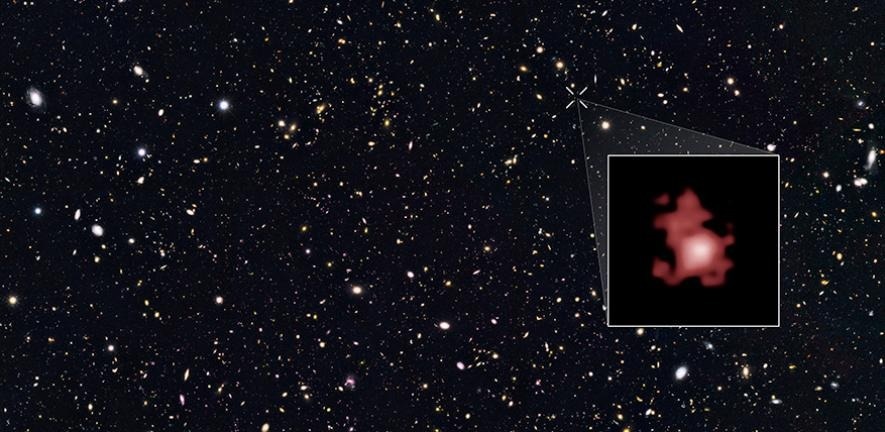The oldest black hole ever seen, which dates back to the beginning of the universe, has been uncovered by researchers, and it is “eating” its host galaxy to extinction.
 The GN-z11 galaxy, taken by the Hubble Space Telescope. Image Credit: NASA, ESA, and P. Oesch (Yale University)
The GN-z11 galaxy, taken by the Hubble Space Telescope. Image Credit: NASA, ESA, and P. Oesch (Yale University)
The black hole was discovered by a multinational team led by the University of Cambridge using the NASA/ESA/CSA James Webb Space Telescope (JWST). The black hole was formed more than 13 billion years ago, 400 million years after the Big Bang. The findings are published in the journal Nature, and according to lead author Professor Roberto Maiolino, they represent “a giant leap forward.”
The fact that this extraordinarily enormous black hole—a few million times the mass of the Sun—exists at such an early stage in the universe calls into question preconceived notions about the formation and evolution of black holes. The supermassive black holes at the center of galaxies like the Milky Way are thought to have grown to their present size over billions of years, according to astronomers.
However, given the magnitude of this recently found black hole, they likely originate in other ways, such as being “born big” or consuming matter at a pace five times faster than previously believed.
Standard concepts state that supermassive black holes are created when dead stars collapse and leave behind remains that can eventually grow into a black hole with a mass of up to 100 times that of the Sun. This newly discovered black hole would take around a billion years to reach its observed magnitude if it expanded in the predicted way. But when this black hole was discovered, the universe had not yet reached a billion years old.
It is very early in the universe to see a black hole this massive, so we have got to consider other ways they might form. Very early galaxies were extremely gas-rich, so they would have been like a buffet for black holes.
Roberto Maiolino, Professor, Experimental Astrophysics, Department of Physics, University of Cambridge
This newborn black hole, like other black holes, is growing by consuming matter from its host galaxy. However, it is discovered that this old black hole consumes matter far more quickly than its siblings did in later epochs.
The young host galaxy, known as GN-z11, is illuminated by an active black hole at its center. Black holes cannot be seen directly; instead, they are identified by the telltale light of a spinning accretion disc that develops on the borders of a black hole. The gas in the accretion disc becomes incredibly hot and begins to glow and emit energy in the ultraviolet spectrum. Astronomers use this powerful glow to find black holes.
GN-z11 is a compact galaxy, approximately a hundred times smaller than the Milky Way, but the black hole is likely impeding its growth. When black holes absorb too much gas, they push it away like an ultrafast wind. This ‘wind’ might halt the process of star formation, gradually killing the galaxy, but it will also kill the black hole itself by cutting off its source of ‘food.’
According to Maiolino, this is the most exciting moment of his career because of the enormous advancement that JWST has brought about.
“It is a new era: the giant leap in sensitivity, especially in the infrared, is like upgrading from Galileo’s telescope to a modern telescope overnight. “Before Webb came online, I thought maybe the universe isn’t so interesting when you go beyond what we could see with the Hubble Space Telescope. But that hasn’t been the case at all: the universe has been quite generous in what it’s showing us, and this is just the beginning,” Maiolino stated.
According to Maiolino, the sensitivity of JWST suggests that in the upcoming months and years, even older black holes may be discovered. In an attempt to clarify the various ways that black holes could form—whether they begin hugely or expand quickly—Maiolino and his colleagues want to utilize upcoming JWST observations to search for smaller “seeds” of black holes.
The study was supported in part by the European Research Council, the Royal Society, and the Science and Technology Facilities Council (STFC), part of UK Research and Innovation (UKRI).
Journal Reference:
Maiolino, R., et. al. (2023) A small and vigorous black hole in the early Universe. Nature. doi:10.1038/s41586-024-07052-5.